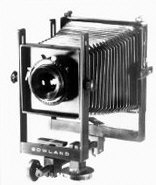|
This
will not be an account of digital vs film photography, but it is a
recognition that both exist and it is implicitly a discussion of what
is attractive in conventional large format photography and a guide
for those considering it.
Reality Check:
If the following list does not put you off the idea of using this
kind of equipment, read on beyond this page:
- Large format equipment tends
to be large and heavy. Typical weight for a 4 x 5 view
camera with a 6-inch lens is 5-7 pounds, plus a 4-5 pound tripod
and several pounds of additional equipment--extra lenses, filters,
meters, film holders.
- Setup time of the camera,
before it is ready for a shot, is minutes
- Exposure calculation is entirely
manual
- Although there are options,
composition is usually on ground glass with the image upside down
and reversed.
- Film materials may range
from 120 rollfilm ($3-4/roll) with 8-10 exposures/roll to 4 x 5-inch
sheetfilm ($1-2/sheet)--and film formats can be much larger and
proportionately more expensive
- These costs are incurred
before you see the result and can't be recovered.
- The film must be processed
by you or a lab
- Black and white processing
is relatively simple and only moderately expensive; color processing
is more complex.
- A wet darkroom, obviously
requires a room with plumbing, and at a minimum several hundred
dollars worth of equipment, including an enlarger.
- Alternately negatives and
transparencies can be scanned and printed digitally.
- The feedback loop in conventional
photography is hours, at a minimum, and often days
- Typically, little of your
digital or 35mm equipment will be very useful to your medium and
large format excursion.
|
|
Image Quality. The comparison of film to digital
image quality is complicated and constantly shifting. Many find that
in color work there is little if any advantage in using film over
digital. Negative film materials have considerably more exposure latitude
than positive film and digital pickups and at least to this point,
can provide better black and white tonal gradation. What follows is
the traditional argument for larger over smaller film images.
- A 35mm frame is 864 square
mm, a 6 x 9 cm negative has 5400 square mm, and a 4 x 5 in negative
has 12,500 square mm, nearly 15 times the area of the 35mm frame.
The less you enlarge the image, the less you magnify its flaws.
Graphic evidence: 
- Lens aberrations are enlarged
along with the image, so as negatives get larger, the effects of
lens aberrations are reduced, assuming similar quality lenses.
- Tonal gradation, that highly
prized quality of B&W photography, improves with reduced grain.
- Most large format cameras
allow for some amount of movement--raising or lowering, tilting
or sliding--of at least the front standard and often the back standard
to control perspective distortion and plane of focus (much more
about this later).
Shooting styles.
Modern cameras with motor drives, metering automation, autofocus lenses
and image stabilization are great for action shots. They catch the
moment in ways that are difficult or impossible when using typical
large format equipment. This automation is seductive but it leads
to choosing this shooting style for all kinds of subjects--even those
that don't require this kind of responsiveness. Visualization--knowing
what you want a shot to be before you look through a viewfinder or
ground glass--increases the probability of a good shot, but chance
plays an important role in the work of even the best photographers
and bare ground glass can be a hair shirt as much as an aid to photographic
vision.
Large format photography
promotes a more deliberate style of shooting. It works best where
setup time is not a major restriction--for example in architectural,
landscape, still life and most nature photography, except perhaps
shots involving animals.
|


